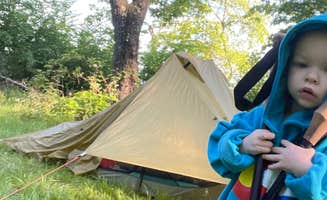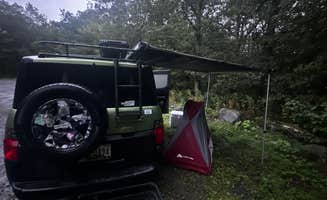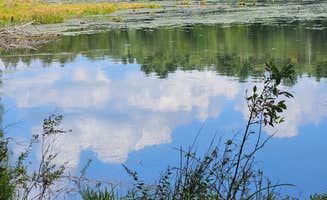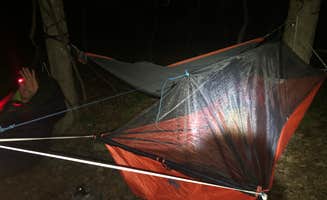Rustic camping near Bloomingdale, New Jersey provides primitive outdoor experiences within the northern New Jersey hardwood forests of the Highlands physiographic region. The area sits within the New York-New Jersey Highlands at elevations typically ranging from 400-1,000 feet, characterized by oak-hickory forests and numerous glacial lakes. Winter temperatures often drop below freezing with significant snowfall, while summer camping requires preparation for temperatures that regularly exceed 85°F with high humidity.
What to do
Trail exploration: Hikers accessing Thunder Swamp Trailhead gain entry to an extensive network of forest paths. "Tons of hiking. Went down Saw Creek trail to a marsh," notes visitor Jason R. The trailhead serves as both overnight parking and access point to multiple interconnected routes.
Hammock camping: The terrain at many sites features adequate tree spacing ideal for hammock setups. At Appalachian Trail- Designated Backpacker Campsite 2, one camper reported it was "a great place for that" despite being "a little on the sloped side for tent camping." The site provides suitable trees for hanging sleep systems.
Wildlife observation: The forested settings offer chances to spot white-tailed deer, wild turkey, and numerous bird species. Several sites border wetland areas or ponds, increasing wildlife viewing opportunities. Campers should maintain food storage discipline, particularly at sites with bear activity.
What campers like
Secluded options: At Hemlock Ridge MUA Dispersed, visitors appreciate the quiet surroundings. Dawn M. describes it as "a quiet peaceful wooded area" where "you can set up your own camp anywhere." The 80-acre forest provides multiple potential camping locations beyond the initial spots.
Accessibility balance: Some sites offer a strategic mix of remoteness without requiring lengthy hikes. "There's plenty of space. We camped nearer to others but there are secluded spots too," writes Katharine T. about the Appalachian Trail campsite, noting its "perfect balance of community and space."
Cost efficiency: Many dispersed sites in the region are free, requiring only adherence to leave-no-trace principles. This makes them attractive alternatives to developed campgrounds that charge fees. Some areas require permits but often at minimal or no cost.
What you should know
Limited amenities: Dispersed sites typically lack facilities. Cory D. notes Hemlock Ridge "isn't a fancy campsite and has no amenities." Most locations have no toilets, trash collection, or potable water, requiring self-sufficiency.
Water planning crucial: Water sources vary significantly between sites. Some lack any nearby water, as one camper indicated about the Appalachian Trail site, requiring hikers to "stock up on water at the Dunnfield creek natural area, or wait until Sunfish pond."
Parking constraints: Most dispersed camping areas have limited vehicle capacity. Hickok Brook presents challenges as "the road is very rough with huge potholes so good clearance is a must," according to Corey, who adds it's "not a good spot for car camping."
Permit requirements: Rules vary by jurisdiction. At Hickok Brook, one camper learned this firsthand: "Where I originally camped was not a spot, according to Ranger. Had to move next to the lake. Need a permit on NY state land. Contact Rangers office of whatever county."
Tips for camping with families
Site selection priorities: Families should prioritize camping areas with established tent pads when available. Access to nearby water sources reduces carrying loads for younger children.
Communication planning: Most dispersed sites have limited or no cell service. "Barely even a signal here," reports a camper at Hemlock Ridge. Families should establish clear emergency protocols before arrival.
Weather preparedness: The region experiences unpredictable weather patterns, particularly thunderstorms in summer. Campsites like Floyd Bennett Field offer limited shelter options during inclement weather, requiring families to pack appropriate tarps and rain gear.
Insect protection: Bug activity can be intense during warmer months. Multiple campers mention this challenge, with one noting "bugs are relentless" at certain sites. Families should bring appropriate repellents, protective clothing, and possibly screened shelters.
Tips from RVers
Road conditions: Access roads to dispersed sites often present challenges for larger vehicles. At Thunder Swamp Trailhead, one visitor describes a "gravel parking lot" with "plenty of shade" suitable for overnight parking, though approach roads may require caution.
Clearance considerations: Many forest roads leading to primitive camping have deteriorated surfaces. Benjamin H. confirms Thunder Swamp offers practical overnight options in a "gravel lot," but approach roads may require higher clearance vehicles.
Size limitations: Traditional RVs face significant limitations at most dispersed sites. Gregg T. notes some areas have specific restrictions: "No motor vehicles beyond where I'm camping," indicating designated parking areas may be separated from camping zones.





